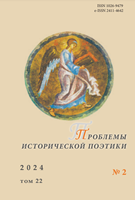«Загадочный автор» из Спасского: письмо И. С. Тургенева к П. В. Анненкову от 14 октября 1853 года
“The Mysterious Author” from Spassky: a Letter from I. S. Turgenev to P. V. Annenkov Dated October 14, 1853
Author(s): Gennady KarpenkoSubject(s): Cultural history, Russian Literature, 19th Century, Sociology of Literature
Published by: Петрозаводский государственный университет
Keywords: I. S. Turgenev; P. V. Annenkov; A. S. Pushkin; writing; attribution; mysterious author; crypto poetics; context; subtext; traditional Russian spelling; sacralization; desacralization; textual poetics;
Summary/Abstract: In the article, the letter of I. S. Turgenev to P. V. Annenkov dated October 14, 1853, which structurally comprises a “physiological essay” about a “little man” and an Easter poem allegedly written by this “little man,” and in fact — by a “mysterious author,” is analyzed. The letter is considered as a letter-work that has already overcome the narrow framework of the epistolary genre during the writer’s life and has become a discussed text. In Turgenev studies, however, the question of the biographical author of the Easter poem remains the main issue in examining the letter: today, in the reader’s space, the poem de facto functions as a work of both Turgenev and Lermontov. The “prosaic” part of the letter about the painter-poet is considered by researchers to be preparatory material for a subsequent work. Meanwhile, the letter is a “cryptographic text,” and as a whole conceals a hidden “Pushkin code,” which is “read” thanks to numerous hints contained both in the letter itself, in its “prosaic” and poetic parts, and in the friendly correspondence between Turgenev and Annenkov. A comparative analysis of the two texts of the Easter poem prepared by the Turgenev academic group, one of which is in a letter dated October 14, 1853, and the other, in the Dubia section, revealed numerous discrepancies in these texts, as well as their significant deviation from the original text published in the Literary Gazette in 1840. In academic texts, all sacred words — the Glory of God, the Son of God — are graphically eliminated. Such eradication of religious and aesthetic feeling, “concealed” in the graphic “decapitation” of the names of Christ, again actualizes the issue of the need to publish the creative heritage of Russian classics in an authentic form.
Journal: Проблемы исторической поэтики
- Issue Year: 22/2024
- Issue No: 2
- Page Range: 88-113
- Page Count: 26
- Language: Russian

